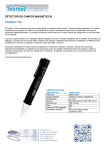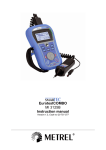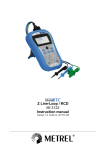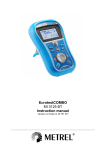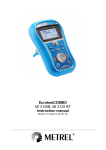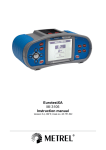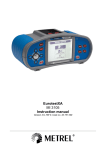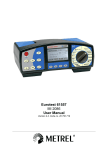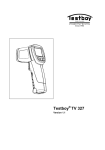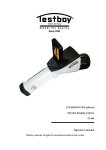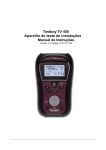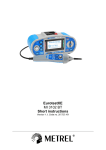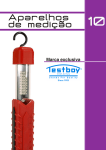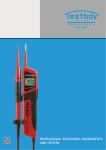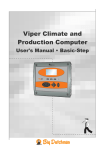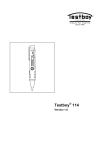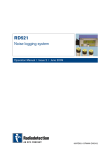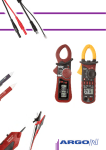Download Technical Specification
Transcript
TESTBOY TV 450 TESTBOY TV 450 (Type B) Instruction manual Version 1.5, Code no. 20 751 769 Distributor: Manufacturer: Testboy GmbH Elektrotechnische Spezialfabrik Beim Alten Flugplatz 3 D - 49377 Vechta Tel: 0049 (0)4441 / 89112-10 Fax: 0049 (0)4441 / 84536 www.testboy.de [email protected] Mark on your equipment certifies that this equipment meets the requirements of the EU (European Union) concerning safety and electromagnetic compatibility regulations © 2009 TESTBOY No part of this publication may be reproduced or utilized in any form or by any means without permission in writing from TESTBOY. 2 TESTBOY TV 450 Table of contents Table of contents 1 Preface ....................................................................................................................6 2 Safety and operational considerations.................................................................7 2.1 Warnings and notes ..........................................................................................7 2.2 Battery and charging .......................................................................................10 2.2.1 New battery cells or cells unused for a longer period ...............................11 2.3 Standards applied ...........................................................................................12 3 Instrument description.........................................................................................13 3.1 Front panel ......................................................................................................13 3.2 Connector panel ..............................................................................................15 3.3 Back side.........................................................................................................16 3.4 Display organization ........................................................................................17 3.4.1 Terminal voltage monitor..........................................................................17 3.4.2 Battery indication......................................................................................17 3.4.3 Message field ...........................................................................................17 3.4.4 Result field ...............................................................................................18 3.4.5 Sound warnings .......................................................................................18 3.4.6 Help screens ............................................................................................18 3.4.7 Backlight and contrast adjustments..........................................................19 3.5 Instrument set and accessories.......................................................................20 3.5.1 Standard set TESTBOY TV 450...............................................................20 3.5.2 Standard set TESTBOY TV 450 (TYPE B)...............................................20 3.5.3 Optional accessories ................................................................................20 4 Instrument operation............................................................................................21 4.1 Function selection ...........................................................................................21 4.2 Settings ...........................................................................................................22 4.2.1 Language .................................................................................................22 4.2.2 Initial settings ...........................................................................................23 4.2.3 Memory (model TESTBOY TV 450 (TYPE B)) .........................................24 4.2.4 Date and time (model TESTBOY TV 450 (TYPE B))................................24 4.2.5 RCD standard ..........................................................................................25 4.2.6 Isc factor...................................................................................................26 4.2.7 Commander support.................................................................................26 5 Measurements ......................................................................................................28 5.1 Voltage, frequency and phase sequence ........................................................28 5.2 Insulation resistance........................................................................................30 5.3 Resistance of earth connection and equipotential bonding .............................32 5.3.1 R LOWΩ, 200 mA resistance measurement ............................................33 5.3.2 Continuous resistance measurement with low current (model TESTBOY TV 450 (TYPE B)) .......................................................34 5.3.3 Compensation of test leads resistance.....................................................35 5.4 Testing RCDs ..................................................................................................36 5.4.1 Contact voltage (RCD Uc)........................................................................37 5.4.2 Trip-out time (RCDt) .................................................................................38 5.4.3 Trip-out current (RCD I)............................................................................39 3 TESTBOY TV 450 Table of contents 5.4.4 RCD Autotest ...........................................................................................40 5.5 Fault loop impedance and prospective fault current ........................................43 5.6 Line impedance and prospective short-circuit current .....................................45 5.7 Earth resistance (model TESTBOY TV 450 (TYPE B)) ...................................47 5.8 PE test terminal ...............................................................................................49 6 Data handling (model TESTBOY TV 450 (TYPE B)) ...........................................51 6.1 Memory organization .......................................................................................51 6.2 Data structure..................................................................................................51 6.3 Storing test results...........................................................................................53 6.4 Recalling test results .......................................................................................54 6.5 Clearing stored data ........................................................................................55 6.5.1 Clearing complete memory content..........................................................55 6.5.2 Clearing measurement(s) in selected location .........................................55 6.5.3 Clearing individual measurements ...........................................................56 6.5.4 Renaming installation structure elements.................................................57 6.6 Communication ...............................................................................................58 7 Upgrading the instrument....................................................................................59 8 Maintenance..........................................................................................................60 8.1 8.2 8.3 8.4 9 Fuse replacement............................................................................................60 Cleaning ..........................................................................................................60 Periodic calibration ..........................................................................................60 Service ............................................................................................................60 Technical specifications ......................................................................................61 9.1 Insulation resistance........................................................................................61 9.2 Continuity ........................................................................................................62 9.2.1 Resistance R LOWΩ ................................................................................62 9.2.2 Resistance CONTINUITY (model TESTBOY TV 450 (TYPE B)) .............62 9.3 RCD testing .....................................................................................................62 9.3.1 General data ............................................................................................62 9.3.2 Contact voltage RCD-Uc ..........................................................................63 9.3.3 Trip-out time .............................................................................................63 9.3.4 Trip-out current.........................................................................................63 9.4 Fault loop impedance and prospective fault current ........................................64 9.4.1 No disconnecting device or FUSE selected .............................................64 9.4.2 RCD selected ...........................................................................................65 9.5 Line impedance and prospective short-circuit current .....................................65 9.6 Resistance to earth (model TESTBOY TV 450 (TYPE B)) ..............................66 9.7 Voltage, frequency, and phase rotation ...........................................................66 9.7.1 Phase rotation ..........................................................................................66 9.7.2 Voltage .....................................................................................................66 9.7.3 Frequency ................................................................................................66 9.7.4 Online terminal voltage monitor................................................................67 9.8 General data....................................................................................................67 A Appendix A - Fuse table.......................................................................................68 A.1 A.2 Fuse table - IPSC ............................................................................................68 Fuse table - impedances (UK).........................................................................70 4 TESTBOY TV 450 Table of contents B Appendix B - Accessories for specific measurements .....................................72 C Appendix F – Country notes................................................................................73 C.1 List of country modifications ............................................................................73 C.2 Modification issues ..........................................................................................73 C.2.1 AT modification - G type RCD ..................................................................73 5 TESTBOY TV 450 Preface 1 Preface Congratulations on your purchase of the TESTBOY instrument and its accessories from TESTBOY. The instrument was designed on a basis of rich experience, acquired through many years of dealing with electric installation test equipment. The TESTBOY instrument is professional, multifunctional, hand-held test instrument intended to perform all the measurements required in order for a total inspection of electrical installations in buildings. The following measurements and tests can be performed: In the models TESTBOY TV 450 and TESTBOY TV 450B Voltage and frequency, Continuity tests, Insulation resistance tests, RCD testing, Fault loop / RCD trip-lock impedance measurements, Line impedance, Phase sequence, Additionally, model TESTBOY TV 450 (Type B) includes: Earthing resistance tests The graphic display with backlight offers easy reading of results, indications, measurement parameters and messages. Two LED Pass/Fail indicators are placed at the sides of the LCD. The operation of the instrument is designed to be as simple and clear as possible and no special training (except for the reading this instruction manual) is required in order to begin using the instrument. In order for operator to be familiar enough with performing measurements in general and their typical applications it is advisable to read TESTBOY handbook Guide for testing and verification of low voltage installations. The instrument is equipped with the entire necessary accessory for comfortable testing. 6 TESTBOY TV 450 Warnings and notes 2 Safety and operational considerations 2.1 Warnings and notes In order to maintain the highest level of operator safety while carrying out various tests and measurements, TESTBOY recommends keeping your TESTBOY instruments in good condition and undamaged. When using the instrument, consider the following general warnings: The symbol on the instrument means »Read the Instruction manual with special care for safe operation«. The symbol requires an action! If the test equipment is used in a manner not specified in this user manual, the protection provided by the equipment could be impaired! Read this user manual carefully, otherwise the use of the instrument may be dangerous for the operator, the instrument or for the equipment under test! Do not use the instrument or any of the accessories if any damage is noticed! If a fuse blows in the instrument, follow the instructions in this manual in order to replace it! Consider all generally known precautions in order to avoid risk of electric shock while dealing with hazardous voltages! Do not use the instrument in supply systems with voltages higher than 550 V! Service intervention or adjustment is only allowed to be carried out by a competent authorized personnel! Use only standard or optional test accessories supplied by your distributor! Consider that older accessories and some of the new optional test accessories compatible with this instrument only meet CAT III / 300 V overvoltage safety rating! This means that maximal allowed voltage between test terminals and ground is 300 V! The instrument comes supplied with rechargeable Ni-Cd or Ni-MH battery cells. The cells should only be replaced with the same type as defined on the battery compartment label or as described in this manual. Do not use standard alkaline battery cells while the power supply adapter is connected, otherwise they may explode! Hazardous voltages exist inside the instrument. Disconnect all test leads, remove the power supply cable and switch off the instrument before All normal safety precautions must be taken in order to avoid risk of electric shock while working on electrical installations! 7 TESTBOY TV 450 Warnings and notes Warnings related to measurement functions: Insulation resistance Insulation resistance measurement should only be performed on de-energized objects! Do not touch the test object during the measurement or before it is fully discharged! Risk of electric shock! When an insulation resistance measurement has been performed on a capacitive object, automatic discharge may not be done immediately! The warning message and the actual voltage is displayed during discharge until voltage drops below 10 V. Do not connect test terminals to external voltage higher than 600 V (AC or DC) in order not to damage the test instrument! Continuity functions Continuity measurements should only be performed on de-energized objects! Parallel impedances or transient currents may influence test results. Testing PE terminal If phase voltage is detected on the tested PE terminal, stop all measurements immediately and ensure the cause of the fault is eliminated before proceeding with any activity! Notes related to measurement functions: General The indicator means that the selected measurement cannot be performed because of irregular conditions on input terminals. Insulation resistance, continuity functions and earth resistance measurements (TESTBOY TV 450 (TYPE B)) can only be performed on de-energized objects. PASS / FAIL indication is enabled when limit is set. Apply appropriate limit value for evaluation of measurement results. In the case that only two of the three wires are connected to the electrical installation under test, only voltage indication between these two wires is valid. Insulation resistance If voltages of higher than 10 V (AC or DC) is detected between test terminals, the insulation resistance measurement will not be performed. If voltages of higher than 10 V (AC or DC) is detected between test terminals, the insulation resistance measurement will not be performed. The instrument automatically discharge tested object after finished measurement. A double click of TEST key starts a continuous measurement. 8 TESTBOY TV 450 Warnings and notes Continuity functions If voltages of higher than 10 V (AC or DC) is detected between test terminals, the continuity resistance test will not be performed. Before performing a continuity measurement, where necessary, compensate test lead resistance. RCD functions Parameters set in one function are also kept for other RCD functions! The measurement of contact voltage does not normally trip an RCD. However, the trip limit of the RCD may be exceeded as a result of leakage current flowing to the PE protective conductor or a capacitive connection between L and PE conductors. The RCD trip-lock sub-function (function selector switch in LOOP position) takes longer to complete but offers much better accuracy of fault loop resistance (in comparison to the RL sub-result in Contact voltage function). RCD trip-out time and RCD trip-out current measurements will only be performed if the contact voltage in the pre-test at nominal differential current is lower than the set contact voltage limit! The autotest sequence (RCD AUTO function) stops when trip-out time is out of allowable time period. Z-LOOP The low limit prospective short-circuit current value depends on fuse type, fuse current rating, fuse trip-out time and impedance scaling factor. The specified accuracy of tested parameters is valid only if the mains voltage is stable during the measurement. Fault loop impedance measurements will trip an RCD. The measurement of fault loop impedance using trip-lock function does not normally trip an RCD. However, the trip limit may be exceeded as a result of leakage current flowing to the PE protective conductor or a capacitive connection between L and PE conductors. Z-LINE In case of measurement of ZLine-Line with the instrument test leads PE and N connected together the instrument will display a warning of dangerous PE voltage. The measurement will be performed anyway. Specified accuracy of tested parameters is valid only if mains voltage is stable during the measurement. L and N test terminals are reversed automatically according to detected terminal voltage (except in UK version). 9 TESTBOY TV 450 Battery and charging 2.2 Battery and charging The instrument uses six AA size alkaline or rechargeable Ni-Cd or Ni-MH battery cells. Nominal operating time is declared for cells with nominal capacity of 2100 mAh. Battery condition is always displayed in the lower right display part. In case the battery is too weak the instrument indicates this as shown in figure 2.1. This indication appears for a few seconds and then the instrument turns itself off. Figure 2.1: Discharged battery indication The battery is charged whenever the power supply adapter is connected to the instrument. The power supply socket polarity is shown in figure 2.2.Internal circuit controls charging and assures maximum battery lifetime. + Figure 2.2: Power supply socket polarity The instrument automatically recognizes the connected power supply adapter and begins charging. Symbols: Indication of battery charging Figure 2.3: Charging indication When connected to an installation, the instruments battery compartment can contain hazardous voltage inside! When replacing battery cells or before opening the battery/fuse compartment cover, disconnect any measuring accessory connected to the instrument and turn off the instrument, Ensure that the battery cells are inserted correctly otherwise the instrument will not operate and the batteries could be discharged. If the instrument is not to be used for a long period of time, remove all batteries from the battery compartment. Alkaline or rechargeable Ni-Cd or Ni-MH batteries (size AA) can be used. TESTBOY recommends only using rechargeable batteries with a capacity of 2100mAh or above. Do not recharge alkaline battery cells! Use only power supply adapter delivered from the manufacturer or distributor of the test equipment to avoid possible fire or electric shock! 10 TESTBOY TV 450 Battery and charging 2.2.1 New battery cells or cells unused for a longer period Unpredictable chemical processes can occur during the charging of new battery cells or cells that have been left unused for a longer period (more than 3 months). Ni-MH and Ni-Cd cells can be subjected to these chemical effects (sometimes called the memory effect). As a result the instrument operation time can be significantly reduced during the initial charging/discharging cycles of the batteries. In this situation, TESTBOY recommend the following procedure to improve the battery lifetime: Procedure ¾ Completely charge the battery. ¾ ¾ Notes At least 14h with in-built charger. This can be performed by using the Completely discharge the battery. instrument normally until the instrument is fully discharged. Repeat the charge / discharge cycle Four cycles are recommended in order to at least 2-4 times. restore the batteries to their normal capacity. Notes: The charger in the instrument is a pack cell charger. This means that the battery cells are connected in series during the charging. The battery cells have to be equivalent (same charge condition, same type and age). One different battery cell can cause an improper charging and incorrect discharging during normal usage of the entire battery pack (it results in heating of the battery pack, significantly decreased operation time, reversed polarity of defective cell,…). If no improvement is achieved after several charge / discharge cycles, then each battery cell should be checked (by comparing battery voltages, testing them in a cell charger, etc). It is very likely that only some of the battery cells are deteriorated. The effects described above should not be confused with the normal decrease of battery capacity over time. Battery also loses some capacity when it is repeatedly charged / discharged. Actual decreasing of capacity, versus number of charging cycles, depends on battery type. This information is provided in the technical specification from battery manufacturer. 11 TESTBOY TV 450 Standards applied 2.3 Standards applied The TESTBOY instruments are manufactured and tested in accordance with the following regulations: Electromagnetic compatibility (EMC) EN 61326 Electrical equipment for measurement, control and laboratory use – EMC requirements Class B (Hand-held equipment used in controlled EM environments) Safety (LVD) EN 61010-1 Safety requirements for electrical equipment for measurement, control and laboratory use – Part 1: General requirements EN 61010-031 Safety requirements for hand-held probe assemblies for electrical measurement and test EN 61010-2-032 Safety requirements for electrical equipment for measurement, control, and laboratory use - Part 2-032: Particular requirements for hand-held and hand-manipulated current sensors for electrical test and measurement Functionality EN 61557 Electrical safety in low voltage distribution systems up to 1000 VAC and 1500 VAC – Equipment for testing, measuring or monitoring of protective measures Part 1 General requirements Part 2 Insulation resistance Part 3 Loop resistance Part 4 Resistance of earth connection and equipotential bonding Part 5 Resistance to earth (TESTBOY TV 450 (TYPE B) only) Part 6 Residual current devices (RCDs) in TT and TN systems Part 7.Phase sequence Part 10 Combined measuring equipment Other reference standards for testing RCDs EN 61008 Residual current operated circuit-breakers without integral overcurrent protection for household and similar uses EN 61009 Residual current operated circuit-breakers with integral overcurrent protection for household and similar uses EN 60364-4-41 Electrical installations of buildings Part 4-41 Protection for safety – protection against electric shock BS 7671 IEE Wiring Regulations (17th edition) AS / NZ 3760 In-service safety inspection and testing of electrical equipment Note about EN and IEC standards: Text of this manual contains references to European standards. All standards of EN 6XXXX (e.g. EN 61010) series are equivalent to IEC standards with the same number (e.g. IEC 61010) and differ only in amended parts required by European harmonization procedure. 12 TESTBOY TV 450 Front panel 3 Instrument description 3.1 Front panel 1 12 2 11 3 10 4 9 5 8 6 7 Figure 3.1: Front panel (picture of TESTBOY TV 450 (TYPE B)) Legend: * Model TESTBOY TV 450 (TYPE B) ** Model TESTBOY TV 450 1 2 3 4 5* 5** LCD TEST 128 x 64 dots matrix display with backlight. Starts measurements. TEST Acts also as the PE touching electrode. UP DOWN MEM CAL Store / recall / clear tests in memory of instrument. Calibrates test leads in Continuity functions. 6 Function selectors Selects test function. 7 Backlight, Contrast Changes backlight level and contrast. 8 9* ON / OFF HELP / CAL Modifies selected parameter. Switches the instrument power on or off. The instrument automatically turns off 15 minutes after the last key was pressed. Accesses help menus. In RCD Auto toggles between top and bottom parts of results field. Calibrates test leads in Continuity functions. 13 TESTBOY TV 450 9** HELP 10 11 12 TAB PASS FAIL Front panel Accesses help menus. In RCD Auto toggles between top and bottom parts of results field. Selects the parameters in selected function. Green indicator Indicates PASS/ FAIL of result. Red indicator 14 TESTBOY TV 450 Connector panel 3.2 Connector panel Figure 3.2: Connector panel (picture of TESTBOY TV 450 (TYPE B)) Legend: * Model TESTBOY TV 450 (TYPE B) ** Model TESTBOY TV 450 1 Test connector Measuring inputs / outputs 2 Protection cover 3 Charger socket 4* USB connector Communication with PC USB (1.1) port. Communication with PC serial port and connection to optional 5* PS/2 connector measuring adapters. 5** PS/2 connector Serial port for upgrading the instrument. Warnings! Maximum allowed voltage between any test terminal and ground is 600 V! Maximum allowed voltage between test terminals is 600 V! Maximum short-term voltage of external power supply adapter is 14 V! 15 TESTBOY TV 450 Back side 3.3 Back side Figure 3.3: Back side Legend: 1 2 3 4 5 6 Side belt Battery compartment cover Fixing screw for battery compartment cover Back panel information label Holder for inclined position of the instrument Magnet for fixing instrument close to tested item (optional) Figure 3.4: Battery compartment Legend: 1 2 3 Battery cells Serial number label Fuse Size AA, alkaline or rechargeable NiMH / NiCd M 0.315 A, 250 V 16 TESTBOY TV 450 Display organization 3.4 Display organization Function name Result field Test parameter field Message field Terminal voltage monitor Figure 3.5: Typical function display Battery indication 3.4.1 Terminal voltage monitor The terminal voltage monitor displays on-line the voltages on the test terminals and information about active test terminals. Online voltages are displayed together with test terminal indication. All three test terminals are used for selected measurement. Online voltages are displayed together with test terminal indication. L and N test terminals are used for selected measurement. L and PE are active test terminals; N terminal should also be connected for correct input voltage condition. 3.4.2 Battery indication The indication indicates the charge condition of battery and connection of external charger . Battery capacity indication. Low battery. Battery is too weak to guarantee correct result. Replace or recharge the battery cells. Recharging in progress (if power supply adapter is connected). 3.4.3 Message field In the message field warnings and messages are displayed. Measurement is running, consider displayed warnings. Conditions on the input terminals allow starting the measurement; consider other displayed warnings and messages. Conditions on the input terminals do not allow starting the measurement, consider displayed warnings and messages. 17 TESTBOY TV 450 Display organization RCD tripped-out during the measurement (in RCD functions). Instrument is overheated. The measurement is prohibited until the temperature decreases under the allowed limit. Result(s) can be stored. (model TESTBOY TV 450 (TYPE B)) High electrical noise was detected during measurement. Results may be impaired. L and N are changed. Warning! High voltage is applied to the test terminals. Warning! Dangerous voltage on the PE terminal! Stop the activity immediately and eliminate the fault / connection problem before proceeding with any activity! Test leads resistance in Continuity measurement is not compensated. Test leads resistance in Continuity measurement is compensated. High resistance to earth of test probes. Results may be impaired. (model TESTBOY TV 450 (TYPE B)) 3.4.4 Result field Measurement result is inside pre-set limits (PASS). Measurement result is out of pre-set limits (FAIL). Measurement is aborted. Consider displayed warnings and messages. 3.4.5 Sound warnings Continuous sound Warning! Dangerous voltage on the PE terminal is detected. 3.4.6 Help screens HELP Opens help screen. Help menus are available in all functions. The Help menu contains schematic diagrams for illustrating how to properly connect the instrument to electric installation. After selecting the measurement you want to perform, press the HELP key in order to view the associated Help menu. Keys in help menu: UP / DOWN HELP Function selectors / TEST Selects next / previous help screen. Scrolls through help screens. Exits help menu. 18 TESTBOY TV 450 Display organization Figure 3.6: Examples of help screens 3.4.7 Backlight and contrast adjustments With the BACKLIGHT key backlight and contrast can be adjusted. Toggles backlight intensity level. Locks high intensity backlight level until power is turned off or the Keep pressed for 1 s key is pressed again. Keep pressed for 2 s Bargraph for LCD contrast adjustment is displayed. Click Figure 3.7: Contrast adjustment menu Keys for contrast adjustment: DOWN UP TEST Function selectors Reduces contrast. Increases contrast. Accepts new contrast. Exits without changes. 19 TESTBOY TV 450 Instrument set and accessories 3.5 Instrument set and accessories 3.5.1 Standard set TESTBOY TV 450 Instrument Short instruction manual Calibration Certificate Mains measuring cable Test lead. 3 x 1.5 m Test probe. 3 pcs Crocodile clip. 3 pcs Set of NiMH battery cells Power supply adapter CD with instruction manual, and “Guide for testing and verification of low voltage installations” handbook. Set of carrying straps 3.5.2 Standard set TESTBOY TV 450 (TYPE B) Instrument Short instruction manual Calibration Certificate Mains measuring cable Test lead. 3 x 1.5 m Test probe. 3 pcs Crocodile clip. 3 pcs Set of NiMH battery cells Power supply adapter CD with instruction manual, and “Guide for testing and verification of low voltage installations” handbook and PC software TESTBOY TV 450 Set of carrying straps RS232 - PS/2 cable USB cable 3.5.3 Optional accessories See the attached sheet for a list of optional accessories that are available on request from your distributor. 20 TESTBOY TV 450 Function selection 4 Instrument operation 4.1 Function selection For selecting test function the FUNCTION SELECTOR shall be used. Keys: Select test / measurement function: FUNCTION SELECTOR UP/DOWN TAB TEST MEM <VOLTAGE TRMS> Voltage and frequency and phase sequence. <R ISO> Insulation resistance. <R LOWΩ> Resistance of earth connections and bondings. <Zline> Line impedance. <Zloop> Fault loop impedance. <RCD> RCD testing. <EARTH RE> Resistance to earth (model TESTBOY TV 450 (TYPE B)). <SETTINGS> General instrument settings. Selects sub-function in selected measurement function. Selects the test parameter to be set or modified. Runs selected test / measurement function. Stores measured results / recalls stored results (model TESTBOY TV 450 (TYPE B)). Keys in test parameter field: UP/DOWN TAB FUNCTION SELECTOR MEM Changes the selected parameter. Selects the next measuring parameter. Toggles between the main functions. Stores measured results / recalls stored results (model TESTBOY TV 450 (TYPE B)). General rule regarding enabling parameters for evaluation of measurement / test result: OFF Parameter ON No limit values, indication: _ _ _. Value(s) – results will be marked as PASS or FAIL in accordance with selected limit. See Chapter 5 for more information about the operation of the instrument test functions. 21 TESTBOY TV 450 Settings 4.2 Settings Different instrument options can be set in the SETTINGS menu. Options in both models are: Selection of language, Setting the instrument to initial values, Selection of reference standard for RCD test, Entering Isc factor, Commander support. Additional options in model TESTBOY TV 450 (TYPE B) are: Recalling and clearing stored results, Setting the date and time, Figure 4.1: Options in Settings menu Keys: UP / DOWN TEST Function selectors Selects appropriate option. Enters selected option. Exits back to main function menu. 4.2.1 Language In this menu the language can be set. Figure 4.2: Language selection Keys: UP / DOWN TEST Function selectors Selects language. Confirms selected language and exits to settings menu. Exits back to main function menu. 22 TESTBOY TV 450 Settings 4.2.2 Initial settings In this menu the instrument settings and measurement parameters and limits can be set to initial (factory) values. Figure 4.3: Initial settings dialogue Keys: TEST Function selectors Restores default settings. Exits back to main function menu without changes. Warning: Customized settings will be lost when this option is used! If the batteries are removed for more than 1 minute the custom made settings will be lost. The default setup is listed below: * model TESTBOY TV 450 (TYPE B) Instrument setting Contrast Isc factor RCD standards Language Commander Function Sub-function EARTH RE* R ISO Low Ohm Resistance R LOWΩ CONTINUITY* Z - LINE Z - LOOP Zs rcd RCD Default value As defined and stored by adjustment procedure 1.00 EN 61008 / EN 61009 English Enabled Parameters / limit value No limit No limit Utest = 500 V No limit No limit Fuse type: none selected Fuse type: none selected Fuse type: none selected RCD t Nominal differential current: IΔN=30 mA RCD type: G Test current starting polarity: (0°) Limit contact voltage: 50 V Current multiplier: ×1 23 TESTBOY TV 450 Settings Note: Initial settings (reset of the instrument) can be recalled also if the TAB key is pressed while the instrument is switched on. 4.2.3 Memory (model TESTBOY TV 450 (TYPE B)) In this menu the stored data can be recalled and deleted. See chapter 6 Data handling for more information. Figure 4.4: Memory options Keys: UP / DOWN TEST Function selectors Selects option. Enters selected option. Exits back to main function menu. 4.2.4 Date and time (model TESTBOY TV 450 (TYPE B)) In this menu date and time can be set. Figure 4.5: Setting date and time Keys: TAB UP / DOWN TEST Function selectors Selects the field to be changed. Modifies selected field. Confirms new setup and exits. Exits back to main function menu. Warning: If the batteries are removed for more than 1 minute the set time and date will be lost. 24 TESTBOY TV 450 Settings 4.2.5 RCD standard In this menu the used standard for RCD tests can be set. Figure 4.6: Selection of RCD test standard Keys: Selects standard. UP / DOWN Confirms selected standard. TEST Exits back to main function menu. Function selectors Maximum RCD disconnection times differ in various standards. The trip-out times defined in individual standards are listed below. Trip-out times according to EN 61008 / EN 61009: ½×IΔN*) IΔN 2×IΔN 5×IΔN General RCDs tΔ > 300 ms tΔ < 300 ms tΔ < 150 ms tΔ < 40 ms (non-delayed) Selective RCDs tΔ > 500 ms 130 ms < tΔ < 500 ms 60 ms < tΔ < 200 ms 50 ms < tΔ < 150 ms (time-delayed) Trip-out times according to EN 60364-4-41: ½×IΔN*) IΔN 2×IΔN 5×IΔN General RCDs tΔ > 999 ms tΔ < 999 ms tΔ < 150 ms tΔ < 40 ms (non-delayed) Selective RCDs tΔ > 999 ms 130 ms < tΔ < 999 ms 60 ms < tΔ < 200 ms 50 ms < tΔ < 150 ms (time-delayed) Trip-out times according to BS 7671: ½×IΔN*) IΔN 2×IΔN 5×IΔN General RCDs tΔ > 1999 ms tΔ < 300 ms tΔ < 150 ms tΔ < 40 ms (non-delayed) Selective RCDs tΔ > 1999 ms 130 ms < tΔ < 500 ms 60 ms < tΔ < 200 ms 50 ms < tΔ < 150 ms (time-delayed) Trip-out times according to AS/NZ**): RCD type IΔN [mA] I ≤ 10 II > 10 ≤ 30 III > 30 IV S *) > 30 ½×IΔN*) tΔ > 999 ms > 999 ms IΔN tΔ 40 ms 300 ms 300 ms 500 ms 130 ms 2×IΔN 5×IΔN tΔ tΔ 40 ms 40 ms 150 ms 40 ms 150 ms 40 ms 200 ms 150 ms 60 ms 50 ms Note Maximum break time Minimum non-actuating time Minimum test period for current of ½×IΔN, RCD shall not trip-out. Test current and measurement accuracy correspond to AS/NZ requirements. **) 25 TESTBOY TV 450 Settings Maximum test times related to selected test current for general (non-delayed) RCD ½×IΔN IΔN 2×IΔN 5×IΔN Standard EN 61008 / EN 61009 300 ms 300 ms 150 ms 40 ms EN 60364-4-41 1000 ms 1000 ms 150 ms 40 ms BS 7671 2000 ms 300 ms 150 ms 40 ms AS/NZ (I, II, III) 1000 ms 1000 ms 150 ms 40 ms Maximum test times related to selected test current for selective (time-delayed) RCD ½×IΔN IΔN 2×IΔN 5×IΔN Standard EN 61008 / EN 61009 500 ms 500 ms 200 ms 150 ms EN 60364-4-41 1000 ms 1000 ms 200 ms 150 ms BS 7671 2000 ms 500 ms 200 ms 150 ms AS/NZ (IV) 1000 ms 1000 ms 200 ms 150 ms 4.2.6 Isc factor In this menu the Isc factor for calculation of short circuit current in Z-LINE and Z-LOOP measurements can be set. Figure 4.7: Selection of Isc factor Keys: UP / DOWN TEST Function selectors Sets Isc value. Confirms Isc value. Exits back to main function menu. Short circuit current Isc in the supply system is important for selection or verification of protective circuit breakers (fuses, over-current breaking devices, RCDs). The default value of Isc factor (ksc) is 1.00. The value should be set according to local regulative. Range for adjustment of the Isc factor is 0.20 ÷ 3.00. 4.2.7 Commander support The support for remote commanders can be switched On/ Off in this menu. Figure 4.8: Selection of commander support 26 TESTBOY TV 450 Settings Keys: UP / DOWN TEST Function selectors Selects commander option. Confirms selected option. Exits back to main function menu. Note: This option is intended to disable the commander’s remote keys. In the case of high EM interfering noise the operation of the commander’s key can be irregular. 27 TESTBOY TV 450 Voltage, frequency, phase sequence 5 Measurements 5.1 Voltage, frequency and phase sequence Voltage and frequency measurement is always active in the terminal voltage monitor. In the special VOLTAGE TRMS menu the measured voltage, frequency and information about detected three-phase connection can be stored. Phase sequence measurement conforms to the EN 61557-7 standard. See chapter 4.1 Function selection for instructions on key functionality. Figure 5.1: Voltage in single phase system Test parameters for voltage measurement There are no parameters to set. result 1.2.3 L/L1 N/L2 PE/L3 L/L1 N/L2 L3 L2 L1 N PE PE/L3 Connections for voltage measurement result 2.1.3 Figure 5.2: Connection of 3-wire test lead and optional adapter in three-phase system N 1 Ro PE N/L2 L/L N/L2 PE/L3 PE/L3 L/L1 L1 L2 L3 N PE L RE Figure 5.3: Connection of plug commander and 3-wire test lead in single-phase system 28 TESTBOY TV 450 Voltage, frequency, phase sequence Voltage measurement procedure * model TESTBOY TV 450 (TYPE B) Select the VOLTAGE TRMS function using the function selector switch. Connect test cable to the instrument. Connect test leads to the item to be tested (see figures 5.2 and 5.3). Store current measurement result by pressing the MEM key (optional)*. Measurement runs immediately after selection of VOLTAGE TRMS function. Figure 5.4: Examples of voltage measurement in three-phase system Displayed results for single phase system: Uln...........Voltage between phase and neutral conductors, Ulpe.........Voltage between phase and protective conductors, Unpe........Voltage between neutral and protective conductors, f ...............frequency. Displayed results for three-phase system: U12..........Voltage between phases L1 and L2, U13..........Voltage between phases L1 and L3, U23..........Voltage between phases L2 and L3, 1.2.3 ........Correct connection – CW rotation sequence, 3.2.1 ........Invalid connection – CCW rotation sequence, f ...............frequency. 29 TESTBOY TV 450 Insulation resistance 5.2 Insulation resistance The Insulation resistance measurement is performed in order to ensure safety against electric shock through insulation. It is covered by the EN 61557-2 standard. Typical applications are: Insulation resistance between conductors of installation, Insulation resistance of non-conductive rooms (walls and floors), Insulation resistance of ground cables, Resistance of semi-conductive (antistatic) floors. See chapter 4.1 Function selection for instructions on key functionality. Figure 5.5: Insulation resistance Test parameters for insulation resistance measurement Uiso Limit Test voltage [50 V, 100 V, 250 V, 500 V, 1000 V] Minimum insulation resistance [OFF, 0.01 MΩ ÷ 200 MΩ] mains voltage switched off closed switches N/L2 PE/L3 L1 L2 L3 N PE L/L1 Test circuits for insulation resistance loads disconnected Figure 5.6: Connections for insulation measurement 30 TESTBOY TV 450 Insulation resistance Insulation resistance measuring procedure * model TESTBOY TV 450 (TYPE B) Select the INS function using the function selector switch. Set the required test voltage. Enable and set limit value (optional). Disconnect tested installation from mains supply (and discharge insulation as required). Connect test cable to the instrument and to the item to be tested (see figure 5.6). Press the TEST key to perform the measurement (double click for continuous measurement and later press to stop the measurement). After the measurement is finished wait until tested item is fully discharged. Store the result by pressing the MEM key (optional)*. Figure 5.7: Example of insulation resistance measurement result Displayed results: R.........................Insulation resistance Um......................Test voltage – actual value. 31 TESTBOY TV 450 5.3 Resistance bonding Resistance of earth connection of earth connection and equipotential The resistance measurement is performed in order to ensure that the protective measures against electric shock through earth connections and bondings are effective. Two sub-functions are available: R LOWΩ - Earth bond resistance measurement according to EN 61557-4 (200 mA), CONTINUITY - Continuous resistance measurement performed with 7 mA (model TESTBOY TV 450 (TYPE B)). See chapter 4.1 Function selection for instructions on key functionality. Figure 5.8: 200 mA RLOW Ω Test parameters for resistance measurement * model TESTBOY TV 450 (TYPE B) TEST Resistance measurement sub-function [R LOWΩ, CONTINUITY*] Limit Maximum resistance [OFF, 0.1 Ω ÷ 20.0 Ω] 32 TESTBOY TV 450 Resistance of earth connection 5.3.1 R LOWΩ, 200 mA resistance measurement The resistance measurement is performed with automatic polarity reversal of the test voltage. Test circuit for R LOWΩ measurement Figure 5.9: Connection of 3-wire test lead plus optional extension lead Resistance to earth connection and equipotential bonding measurement procedure * model TESTBOY TV 450 (TYPE B) Select continuity function using the function selector switch. Set sub-function to R LOWΩ. Enable and set limit (optional). Connect test cable to the the instrument. Compensate the test leads resistance (if necessary, see section 5.3.3). Disconnect from mains supply and discharge installation to be tested. Connect the test leads to the appropriate PE wiring (see figure 5.9). Press the TEST key to perform the measurement. After the measurement is finished store the result by pressing the MEM button (optional)*. Figure 5.10: Example of RLOW result Displayed result: R................R LOWΩ resistance. R+..............Result at positive polarity R-...............Result at negative test polarity 33 TESTBOY TV 450 Resistance of earth connection 5.3.2 Continuous resistance measurement with low current (model TESTBOY TV 450 (TYPE B)) In general, this function serves as standard Ω-meter with a low testing current. The measurement is performed continuously without polarity reversal. The function can also be applied for testing continuity of inductive components. Test circuit for continuous resistance measurement Figure 5.11: 3-wire test lead application Continuous resistance measurement procedure Select continuity function using the function selector switch. Set sub-function CONTINUITY. Enable and set the limit (optional). Connect test cable to the instrument. Compensate test leads resistance (if necessary, see section 5.3.3). Disconnect from mains supply and discharge the object to be tested. Connect test leads to the tested object (see figure 5.11). Press the TEST key to begin performing a continuous measurement. Press the TEST key to stop measurement. After the measurement is finished, store the result (optional). Figure 5.12: Example of continuous resistance measurement Displayed result: R............Resistance Note: Continuous buzzer sound indicates that measured resistance is less than 2 Ω. 34 TESTBOY TV 450 Resistance of earth connection 5.3.3 Compensation of test leads resistance This chapter describes how to compensate the test leads resistance in both continuity functions, R LOWΩ and CONTINUITY (model TESTBOY TV 450 (TYPE B)). Compensation is required to eliminate the influence of test leads resistance and the internal resistances of the instrument on the measured resistance. The lead compensation is therefore a very important feature to obtain correct result. Each of R LOWΩ and CONTINUITY (model TESTBOY TV 450 (TYPE B)) has own compensation. successfully. symbol is displayed if the compensation was carried out Circuits for compensating the resistance of test leads N/L2 PE/L3 N/L2 PE/L3 L/L1 L/L1 prolongation lead Figure 5.13: Shorted test leads Compensation of test leads resistance procedure Select R LOWΩ or CONTINUITY (model TESTBOY TV 450 (TYPE B)) function. Connect test cable to the instrument and short the test leads together (see figure 5.13). Press TEST to perform resistance measurement. Press the CAL key to compensate leads resistance. Figure 5.14: Results with old calibration values Figure 5.15: Results with new calibration values Note: The highest value for lead compensation is 5 Ω. If the resistance is higher the compensation value is set back to default value. is displayed if no calibration value is stored. 35 TESTBOY TV 450 Testing RCD 5.4 Testing RCDs Various test and measurements are required for verification of RCD(s) in RCD protected installations. Measurements are based on the EN 61557-6 standard. The following measurements and tests (sub-functions) can be performed: Contact voltage, Trip-out time, Trip-out current, RCD autotest. See chapter 4.1 Function selection for instructions on key functionality. Figure 5.16: RCD test Test parameters for RCD test and measurement TEST IΔN RCD sub-function test [RCDt, RCD I, AUTO, Uc]. Rated RCD residual current sensitivity IΔN [10 mA, 30 mA, 100 mA, 300 mA, 500 mA, 1000 mA]. type RCD type [ , ], test current waveform plus starting polarity [ , , , , *, *]. MUL Multiplication factor for test current [½, 1, 2, 5 IΔN]. Ulim Conventional touch voltage limit [25 V, 50 V]. * Model TESTBOY TV 450 (TYPE B) Notes: Ulim can be selected in the Uc sub-function only. The instrument is intended for testing of General (non-delayed) and S elective (timedelayed) RCDs, which are suited for: Alternating residual current (AC type, marked with symbol), Pulsating residual current (A type, marked with symbol). Pulsating residual current (A type, marked with symbol). Model TESTBOY TV 450 (Type B): DC residual current (B type, marked with symbol). Time delayed RCDs have delayed response characteristics. As the contact voltage pretest or other RCD tests influence the time delayed RCD it takes a certain period to recover into normal state. Therefore a time delay of 30 s is inserted before performing trip-out test by default. 36 TESTBOY TV 450 Testing RCD Connections for testing RCD L1 L2 L3 N PE PE/L3 L/L 1 N/L2 N Ro PE L RE Figure 5.17: Connecting the plug commander and the 3-wire test lead 5.4.1 Contact voltage (RCD Uc) A current flowing into the PE terminal causes a voltage drop on earth resistance, i.e. voltage difference between PE equipotential bonding circuit and earth. This voltage difference is called contact voltage and is present on all accessible conductive parts connected to the PE. It shall always be lower than the conventional safety limit voltage. The contact voltage is measured with a test current lower than ½ IΔN to avoid trip-out of the RCD and then normalized to the rated IΔN. Contact voltage measurement procedure * model TESTBOY TV 450 (TYPE B) Select the RCD function using the function selector switch. Set sub-function Uc. Set test parameters (if necessary). Connect test cable to the instrument. Connect test leads to the item to be tested (see figure 5.17). Press the TEST key to perform the measurement. Store the result by pressing the MEM key (optional)*. The contact voltage result relates to the rated nominal residual current of the RCD and is multiplied by an appropriate factor (depending on RCD type and type of test current). The 1.05 factor is applied to avoid negative tolerance of result. See table 5.1 for detailed contact voltage calculation factors. 37 TESTBOY TV 450 G Contact voltage Uc proportional to 1.05×IΔN 2×1.05×IΔN 1.4×1.05×IΔN 2×1.4×1.05×IΔN 2×1.05×IΔN 2×2×1.05×IΔN 2×1.05×IΔN S 2×2×1.05×IΔN RCD type AC AC A A A A B B Testing RCD G S G S G S Rated IΔN any ≥ 30 mA Both models < 30 mA any Model TESTBOY TV 450 (Type B) only Table 5.1: Relationship between Uc and IΔN Loop resistance is indicative and calculated from Uc result (without additional U proportional factors) according to: RL = C . I ΔN UK version Figure 5.18: Example of contact voltage measurement results Displayed results: Uc........Contact voltage. Rl.........Fault loop resistance. 5.4.2 Trip-out time (RCDt) Trip-out time measurement verifies the sensitivity of the RCD at different residual currents. Trip-out time measurement procedure * model TESTBOY TV 450 (TYPE B) Select the RCD function using the function selector switch. Set sub-function RCDt. Set test parameters (if necessary). Connect test cable to the instrument. Connect test leads to the item to be tested (see figure 5.17). Press the TEST key to perform the measurement. Store the result by pressing the MEM key (optional)*. 38 TESTBOY TV 450 Testing RCD Figure 5.19: Example of trip-out time measurement results Displayed results: t ...........Trip-out time, Uc........Contact voltage for rated IΔN. 5.4.3 Trip-out current (RCD I) A continuously rising residual current is intended for testing the threshold sensitivity for RCD trip-out. The instrument increases the test current in small steps through appropriate range as follows: Slope range Start value End value AC 0.2×IΔN 1.1×IΔN A (IΔN ≥ 30 mA) 0.2×IΔN 1.5×IΔN A (IΔN = 10 mA) 0.2×IΔN 2.2×IΔN B 0.2×IΔN 2.2×IΔN RCD type Waveform Sine Note Both models Pulsed DC Model TESTBOY TV 450 (TYPE B) only Maximum test current is IΔ (trip-out current) or end value in case the RCD didn’t trip-out. Trip-out current measurement procedure * model TESTBOY TV 450 (TYPE B) Select the RCD function using the function selector switch. Set sub-function RCD I. Set test parameters (if necessary). Connect test cable to the instrument. Connect test leads to the item to be tested (see figure 5.17). Press the TEST key to perform the measurement. Store the result by pressing the MEM key (optional)*. Trip-out After the RCD is turned on again Figure 5.20: Trip-out current measurement result example 39 TESTBOY TV 450 Testing RCD Displayed results: I ...........Trip-out current, Uci Contact voltage at trip-out current I or end value in case the RCD didn’t trip, t ...........Trip-out time. 5.4.4 RCD Autotest RCD autotest function is intended to perform a complete RCD test (trip-out time at different residual currents, trip-out current and contact voltage) in one set of automatic tests, guided by the instrument. Additional key: HELP / DISPLAY Toggles between top and bottom part of results field. RCD autotest procedure * model TESTBOY TV 450 (TYPE B) RCD Autotest steps Select the RCD function using the function selector switch. Set sub-function AUTO. Set test parameters (if necessary). Connect test cable to the instrument. Connect test leads to the to the item to be tested (see figure 5.17). Press the TEST key to perform the test. Test with IΔN, 0° (step 1). Re-activate RCD. Test with IΔN, 180° (step 2). Re-activate RCD. Test with 5×IΔN, 0° (step 3). Re-activate RCD. Test with 5×IΔN, 180° (step 4). Re-activate RCD. Test with ½×IΔN, 0° (step 5). Test with ½×IΔN, 180° (step 6). Trip-out current test, 0° (step 7). Re-activate RCD. Trip-out current test, 180° (step 8). Re-activate RCD. Store the result by pressing the MEM key (optional)*. 40 Notes Start of test RCD should trip-out RCD should trip-out RCD should trip-out RCD should trip-out RCD should not tripout RCD should not tripout RCD should trip-out RCD should trip-out End of test TESTBOY TV 450 Testing RCD Result examples: Step 1 Step 2 Step 3 Step 4 Step 5 Step 6 Step 7 Step 8 Figure 5.21: Individual steps in RCD autotest Top Bottom Figure 5.22: Two parts of result field in RCD autotest 41 TESTBOY TV 450 Testing RCD Displayed results: x1 ........Step 1 trip-out time ( , IΔN, 0º), , IΔN, 180º), x1 ........Step 2 trip-out time ( x5 ........Step 3 trip-out time ( , 5×IΔN, 0º), x5 ........Step 4 trip-out time ( , 5×IΔN, 180º), , ½×IΔN, 0º), x½ .......Step 5 trip-out time ( x½ .......Step 6 trip-out time ( , ½×IΔN, 180º), I .........Step 7 trip-out current (0º), I .........Step 8 trip-out current (180º), Uc........Contact voltage for rated IΔN. Notes: The autotest sequence is immediately stopped if any incorrect condition is detected, e.g. excessive Uc or trip-out time out of bounds. Auto test is finished without x5 tests in case of testing the RCD type A with rated residual currents of IΔn = 300 mA, 500 mA, and 1000 mA. In this case auto test result passes if all other results pass, and indications for x5 are omitted. Tests for sensitivity (IΔ, steps 7 and 8) are omitted for selective type RCD. 42 TESTBOY TV 450 Fault loop impedance 5.5 Fault loop impedance and prospective fault current Fault loop is a loop comprised by mains source, line wiring and PE return path to the mains source. The instrument measures the impedance of the loop and calculates the short circuit current. The measurement is covered by requirements of the EN 61557-3 standard. See chapter 4.1 Function selection for instructions on key functionality. Figure 5.23: Fault loop impedance Test parameters for fault loop impedance measurement Test Selection of fault loop impedance sub-function [Zloop, Zs rcd] Fuse type Selection of fuse type [---, NV, gG, B, C, K, D] Fuse I Rated current of selected fuse Fuse T Maximum breaking time of selected fuse Lim Minimum short circuit current for selected fuse. See Appendix A for reference fuse data. Circuits for measurement of fault loop impedance L1 L2 L3 N PE PE/L3 L/L 1 N/L2 N Ro RE Figure 5.24: Connection of plug cable and 3-wire test lead 43 PE L TESTBOY TV 450 Fault loop impedance Fault loop impedance measurement procedure * model TESTBOY TV 450 (TYPE B) Select the Zloop or Zs rcd subfunction using the function selector switch and ¿/À keys Select test parameters (optional). Connect test cable the TESTBOY TV 450. Connect test leads to the the item to be tested (see figure 5.24 and 5.17). Press the TEST key to perform the measurement. Store the result by pressing the MEM key (optional)*. Figure 5.25: Examples of loop impedance measurement result Displayed results: Z ..............Fault loop impedance, ISC ............Prospective fault current, Lim ..........Low limit prospective short-circuit current value or high limit fault loop impedance value for the UK version. Prospective fault current ISC is calculated from measured impedance as follows: ISC = Un × kSC Z where: Un ........ Nominal UL-PE voltage (see table below), ksc ....... Correction factor for Isc (see chapter 4.2.6). Un 115 V 230 V Input voltage (L-PE) (100 V ≤ UL-PE < 160 V) (160 V ≤ UL-PE ≤ 264 V) Notes: High fluctuations of mains voltage can influence the measurement results (the noise sign is displayed in the message field). In this case it is recommended to repeat few measurements to check if the readings are stable. This measurement will trip-out the RCD in RCD-protected electrical installation if test Zloop is selected. Select Zs rcd to prevent trip-out of RCD in RCD protected installation. 44 TESTBOY TV 450 Line impedance 5.6 Line impedance and prospective short-circuit current Line impedance is measured in loop comprising of mains voltage source and line wiring. It is covered by requirements of the EN 61557-3 standard. See chapter 4.1 Function selection for instructions on key functionality. Figure 5.26: Line impedance Test parameters for line impedance measurement FUSE type Selection of fuse type [---, NV, gG, B, C, K, D] FUSE I Rated current of selected fuse FUSE T Maximum breaking time of selected fuse Lim Minimum short circuit current for selected fuse. See Appendix A for reference fuse data. Connections for measurement of line impedance N Ro PE N/L2 L/L 1 N/L2 PE/L3 PE/L3 L/L1 L1 L2 L3 N PE L RE Figure 5.27: Phase-neutral or phase-phase line impedance measurement – connection of plug commander and 3-wire test lead Line impedance measurement procedure * model TESTBOY TV 450 (TYPE B) Select the Z-LINE function using the function selector switch. Select test parameters (optional). Connect test cable to the instrument. Connect test leads to the to the item to be tested (see figure 5.27). Press the TEST key to perform the measurement. Store the result by pressing the MEM key (optional)*. 45 TESTBOY TV 450 Earth resistance Line to neutral Line to line Figure 5.28: Examples of line impedance measurement result Displayed results: Z ..............Line impedance, ISC ............Prospective short-circuit current, Lim ..........Low limit prospective short-circuit current value or high limit line impedance value for the UK version. Prospective short circuit current is calculated as follows: ISC = Un × kSC Z where: Un ........ Nominal L-N or L1-L2 voltage (see table below), ksc ....... Correction factor for Isc (see chapter 4.2.6). Un Input voltage range (L-N or L1-L2) 115 V (100 V ≤ UL-N < 160 V) 230 V (160 V ≤ UL-N ≤ 264 V) 400 V (264 V < UL-N ≤ 440 V) Note: High fluctuations of mains voltage can influence the measurement results (the noise sign is displayed in the message field). In this case it is recommended to repeat few measurements to check if the readings are stable. 46 TESTBOY TV 450 Earth resistance 5.7 Earth resistance (model TESTBOY TV 450 (TYPE B)) Earth resistance is one of the most important parameters for protection against electric shock. Main earthing arrangements, lightning systems, local earthings, etc can be verified with the earthing resistance test. The measurement conforms to the EN 615575 standard. See chapter 4.1 Function selection for instructions on key functionality. Figure 5.29: Earth resistance Test parameters for earth resistance measurement Limit Maximum resistance OFF, 1 Ω ÷ 5 kΩ Connections for earth resistance measurement Figure 5.30: Resistance to earth, measurement of main installation earthing 47 TESTBOY TV 450 Earth resistance Figure 5.31: Resistance to earth, measurement of a lighting protection system Earth resistance measurements, common measurement procedure Select EARTH function using the function selector switch. Enable and set limit value(optional). Connect test leads to the instrument Connect the item to be tested (see figures 5.30, 5.31). Press the TEST key to perform the measurement.. Store the result by pressing the MEM key (optional). Figure 5.32: Example of earth resistance measurement result Displayed results for earth resistance measurement: R..............Earth resistance, Rp............Resistance of S (potential) probe, Rc............Resistance of H (current) probe. Notes: High resistance of S and H probes could influence the measurement results. In this case, “Rp” and “Rc” warnings are displayed. There is no pass / fail indication in this case. High noise currents and voltages in earth could influence the measurement results. The tester displays the “noise” warning in this case. Probes must be placed at sufficient distance from the measured object. 48 TESTBOY TV 450 PE test terminal 5.8 PE test terminal It can happen that a dangerous voltage is applied to the PE wire or other accessible metal parts. This is a very dangerous situation since the PE wire and MPEs are considered to be earthed. An often reason for this fault is incorrect wiring (see examples below). When touching the TEST key in all functions that require mains supply the user automatically performs this test. Examples for application of PE test terminal L1 N PE Reversed phase and protection conductors! THE MOST DANGEROUS SITUATION! Figure 5.33: Reversed L and PE conductors (application of plug commander) L1 N PE PE/L3 N/L2 Reversed phase and protection conductors! L/ L1 N MOST DANGEROUS SITUATION! PE L Figure 5.34: Reversed L and PE conductors (application of 3-wire test lead) 49 TESTBOY TV 450 PE test terminal PE terminal test procedure Connect test cable to the instrument. Connect test leads to the to the item to be tested (see figures 5.33 and 5.34). Touch PE test probe (the TEST key) for at least one second. If PE terminal is connected to phase voltage the warning message is displayed, instrument buzzer is activated, and further measurements are disabled in ZLOOP and RCD functions. Warning: If dangerous voltage is detected on the tested PE terminal, immediately stop all measurements, find and remove the fault! Notes: In the SETTINGS and VOLTAGE TRMS menus the PE terminal is not tested. PE test terminal does not operate in case the operator’s body is completely insulated from floor or walls! 50 TESTBOY TV 450 Memory organization 6 Data handling (model TESTBOY TV 450 (TYPE B)) 6.1 Memory organization Measurement results together with all relevant parameters can be stored in the instrument’s memory. After the measurement is completed, results can be stored to the flash memory of the instrument, together with the sub-results and function parameters. 6.2 Data structure The instrument’s memory place is divided into 3 levels each containing 199 locations. The number of measurements that can be stored into one location is not limited. The data structure field describes the location of the measurement (which object, block, fuse) and where can be accessed. In the measurement field there is information about type and number of measurements that belong to the selected structure element (object and block and fuse). The main advantages of this system are: Test results can be organized and grouped in a structured manner that reflects the structure of typical electrical installations. Customized names of data structure elements can be uploaded from TESTBOY TV 450 PC SW. Simple browsing through structure and results. Test reports can be created with no or little modifications after downloading results to a PC. Figure 6.1: Data structure and measurement fields 51 TESTBOY TV 450 Memory organization Data structure field Memory operation menu Data structure field 1st level: OBJECT: Default location name (object and its successive number). nd 2 level: BLOCK: Default location name (block and its successive number). rd 3 level: FUSE: Default location name (fuse and its successive number). 001: No. of selected element. No. of measurements in selected location [No. of measurements in selected location and its sublocations] Measurement field Type of stored measurement in the selected location. No. of selected test result / No. of all stored test results in selected location. 52 TESTBOY TV 450 Storing test results 6.3 Storing test results After the completion of a test the results and parameters are ready for storing ( icon is displayed in the information field). By pressing the MEM key, the user can store the results. Figure 6.2: Save test menu Memory available for storing results. Keys in save test menu - data structure field: Selects the location element (Object / Block / Fuse) Selects number of selected location element (1 to 199) Saves test results to the selected location and returns to the MEM measuring menu. Function selectors Exits back to main function menu. / TEST TAB UP / DOWN Notes: The instrument offers to store the result to the last selected location by default. If the measurement is to be stored to the same location as the previous one just press the MEM key twice 53 TESTBOY TV 450 Recalling test results 6.4 Recalling test results Press the MEM key in a main function menu when there is no result available for storing or select MEMORY in the SETTINGS menu. Figure 6.3: Recall menu - installation structure field selected Figure 6.4: Recall menu - measurements field selected Keys in recall memory menu (installation structure field selected): TAB UP / DOWN Function selectors / TEST MEM Selects the location element (Object / Block / Fuse). Enters measurements field. Selects the location element in selected level. Exits back to main function menu. Enters measurements field. Keys in recall memory menu (measurements field): UP / DOWN TAB Function selector / TEST MEM Selects the stored measurement. Returns to installation structure field. Exits back to main function menu. View selected measurement results. Figure 6.5: Example of recalled measurement result Keys in recall memory menu (measurement results are displayed) UP / DOWN MEM Function selector TEST Displays measurement results stored in selected location Returns to measurements field. / Exits back to main function menu. 54 TESTBOY TV 450 Clearing stored data 6.5 Clearing stored data 6.5.1 Clearing complete memory content Select CLEAR ALL MEMORY in MEMORY menu. A warning will be displayed. Figure 6.6: Clear all memory Keys in clear all memory menu TEST Function selectors Confirms clearing of complete memory content. Exits back to main function menu without changes. Figure 6.7: Clearing memory in progress 6.5.2 Clearing measurement(s) in selected location Select DELETE RESULTS in MEMORY menu. Figure 6.8: Clear measurements menu (data structure field selected) Keys in delete results menu (installation structure field selected): TAB UP / DOWN Function selector / TEST HELP Selects the location element (Object / D. Board / Circuit or Bonding or Electrode). Selects the location element in selected level. Exits back to main function menu. Enters dialog box for deleting all measurements in selected location and its sublocations. 55 TESTBOY TV 450 MEM Clearing stored data Enters measurements measurements. field for deleting individual Keys in dialog for confirmation to clear results in selected location: TEST MEM Function selectors Deletes all results in selected location. Exits back to delete results menu without changes. Exits back to main function menu without changes. 6.5.3 Clearing individual measurements Select DELETE RESULTS in MEMORY menu. Figure 6.9: Menu for clearing individual measurement (installation structure field selected) Keys in delete results menu (installation structure field selected): TAB UP / DOWN Function selector / TEST MEM Selects the location element (Object / D. Board / Circuit or Bonding or Electrode). Selects the location element in selected level. Exits back to main function menu. Enters measurements field. Keys in delete results menu (measurements field selected): TAB UP / DOWN TEST HELP Function selector Returns to installation structure field. Selects measurement. Opens dialog box for confirmation to clear selected measurement. Enters dialog box for deleting selected measurement. Exits back to main function menu without changes. Keys in dialog for confirmation to clear selected result(s): TEST MEM Function selector Deletes selected measurement result. Exits back to measurements field without changes. Exits back to main function menu without changes. 56 TESTBOY TV 450 Clearing stored data Figure 6.11: Display after measurement was cleared Figure 6.10: Dialog for confirmation 6.5.4 Renaming installation structure elements Default installation structure elements are ‘Object’, ‘D.Board’, ‘Circuit’, ‘Electrode’ and ‘Circuit’. In the PC SW package TESTBOY TV 450 default names can be changed with customized names that corresponds the installation under test. Refer to PC SW TESTBOY TV 450 HELP menu for information how to upload customized installation names to the instrument. Figure 6.12: Example of menu with customized installation structure names 57 TESTBOY TV 450 Communication 6.6 Communication Stored results can be transferred to a PC. A special communication program on the PC automatically identifies the instrument and enables data transfer between the instrument and the PC. There are two communication interfaces available on the instrument: USB or RS 232. The instrument automatically selects the communication mode according to detected interface. USB interface has priority. Figure 6.13: Interface connection for data transfer over PC COM port How to transfer stored data: RS 232 communication: connect a PC COM port to the instrument PS/2 connector using the PS/2 - RS232 serial communication cable; USB communication selected: connect a PC USB port to the instrument USB connector using the USB interface cable. Switch on the PC and the instrument. Run the TESTBOY TV 450 program. The PC and the instrument will automatically recognize each other. The instrument is prepared to download data to the PC. The program TESTBOY TV 450 is a PC software running on Windows 95/98, Windows NT, Windows 2000, Windows XP, Windows Vista. Read the file README_TESTBOY TV 450.txt on CD for instructions about installing and running the program. Note: USB drivers should be installed on PC before using the USB interface. Refer to USB installation instructions available on installation CD. 58 TESTBOY TV 450 Upgrading the instrument 7 Upgrading the instrument The instrument can be upgraded from a PC via the RS232 communication port. This enables to keep the instrument up to date even if the standards or regulations change. The upgrade can be carried with help of a special upgrading software and the communication cable as shown on Figure 6.13. Please contact your dealer for more information. 59 TESTBOY TV 450 Maintenance 8 Maintenance Unauthorized persons are not allowed to open the TESTBOY TV 450 instrument. There are no user replaceable components inside the instrument, except the battery and fuse under rear cover. 8.1 Fuse replacement There is a fuse under back cover of the TESTBOY TV 450 instrument. F1 M 0.315 A / 250 V, 20×5 mm This fuse protects internal circuitry for continuity functions if test probes are connected to the mains supply voltage by mistake during measurement. Warnings: Disconnect all measuring accessory and switch off the instrument before opening battery / fuse compartment cover, hazardous voltage inside! Replace blown fuse with original type only, otherwise the instrument may be damaged and/or operator’s safety impaired! Position of fuse can be seen in Figure 3.4 in chapter 3.3 Back panel. 8.2 Cleaning No special maintenance is required for the housing. To clean the surface of the instrument use a soft cloth slightly moistened with soapy water or alcohol. Then leave the instrument to dry totally before use. Warnings: Do not use liquids based on petrol or hydrocarbons! Do not spill cleaning liquid over the instrument! 8.3 Periodic calibration It is essential that the test instrument is regularly calibrated in order that the technical specification listed in this manual is guaranteed. We recommend an annual calibration. Only an authorized technical person can do the calibration. Please contact your dealer for further information. 8.4 Service For repairs under warranty, or at any other time, please contact your distributor. 60 TESTBOY TV 450 Technical specification 9 Technical specifications 9.1 Insulation resistance Insulation resistance (nominal voltages 50 VDC, 100 VDC and 250 VDC) Measuring range according to EN61557 is 0.15 MΩ ÷ 199.9 MΩ. Accuracy Measuring range (MΩ) Resolution (MΩ) 0.01 0.00 ÷ 19.99 ±(5 % of reading + 3 digits) 20.0 ÷ 99.9 ±(10 % of reading) 0.1 100.0 ÷ 199.9 ±(20 % of reading) Insulation resistance (nominal voltages 500 VDC and 1000 VDC) Measuring range according to EN61557 is 0.15 MΩ ÷ 1 GΩ. Accuracy Measuring range (MΩ) Resolution (MΩ) 0.01 0.00 ÷ 19.99 ±(5 % of reading + 3 digits) 0.1 20.0 ÷ 199.9 ±(5 % of reading) 1 200 ÷ 999 ±(10 % of reading) Voltage Measuring range (V) 0 ÷ 1200 Resolution (V) 1 Accuracy ±(3 % of reading + 3 digits) Nominal voltages ...............................50 VDC, 100 VDC, 250 VDC, 500 VDC, 1000 VDC Open circuit voltage ...........................-0 % / +20 % of nominal voltage Measuring current..............................min. 1 mA at RN=UN×1 kΩ/V Short circuit current........................... max. 3 mA The number of possible tests............ > 1200, with a fully charged battery Auto discharge after test. Specified accuracy is valid if 3-wire test lead is used while it is valid up to 100 MΩ if tip commander is used. Specified accuracy is valid up to 100 MΩ if relative humidity > 85 %. In case the instrument gets moistened, the results could be impaired. In such case, it is recommended to dry the instrument and accessories for at least 24 hours. The error in operating conditions could be at most the error for reference conditions (specified in the manual for each function) ±5 % of measured value. 61 TESTBOY TV 450 Technical specification 9.2 Continuity 9.2.1 Resistance R LOWΩ Measuring range according to EN61557 is 0.16 Ω ÷ 1999 Ω. Accuracy Measuring range R (Ω) Resolution (Ω) 0.01 0.00 ÷ 19.99 ±(3 % of reading + 3 digits) 0.1 20.0 ÷ 199.9 ±(5 % of reading) 1 200 ÷ 1999 Open-circuit voltage...........................6.5 VDC ÷ 9 VDC Measuring current..............................min. 200 mA into load resistance of 2 Ω Test lead compensation.....................up to 5 Ω The number of possible tests ............> 2000, with a fully charged battery Automatic polarity reversal of the test voltage. 9.2.2 Resistance CONTINUITY (model TESTBOY TV 450 (TYPE B)) Measuring range (Ω) 0.0 ÷ 19.9 20 ÷ 1999 Resolution (Ω) 0.1 1 Accuracy ±(5 % of reading + 3 digits) Open-circuit voltage...........................6.5 VDC ÷ 9 VDC Short-circuit current ...........................max. 8.5 mA Test lead compensation.....................up to 5 Ω 9.3 RCD testing Note: All data (marked with “*”) regarding B type RCDs are valid for model TESTBOY TV 450 (TYPE B) only. 9.3.1 General data Nominal residual current (A,AC) ........10 mA, 30 mA, 100 mA, 300 mA, 500 mA, 1000 mA Nominal residual current accuracy.....-0 / +0.1⋅IΔ; IΔ = IΔN, 2×IΔN, 5×IΔN -0.1⋅IΔ / +0; IΔ = 0.5×IΔN AS / NZ selected: ± 5 % Test current shape.............................Sine-wave (AC), pulsed (A), smooth DC (B)* DC offset for pulsed test current ........6 mA (typical) RCD type ...........................................G (non-delayed), S (time-delayed) Test current starting polarity ............. 0 º or 180 º Voltage range ....................................50 V ÷ 264 V (45 Hz ÷ 65 Hz) 62 TESTBOY TV 450 IΔN (mA) 10 30 100 300 500 1000 IΔN × 1/2 AC A 5 3.5 15 10.5 50 35 150 105 250 175 500 350 Technical specification B* 5 15 50 150 250 500 IΔN × 1 AC A 10 20 30 42 100 141 300 424 500 707 1000 1410 B* 20 60 200 600 1000 n.a. IΔN × 2 AC A 20 40 60 84 200 282 600 848 1000 1410 2000 n.a. B 40 120 400 n.a. n.a. n.a. IΔN × 5 AC A 50 100 150 212 500 707 1500 n.a. 2500 n.a. n.a. n.a. B* 100 300 1000 n.a. n.a. n.a. RCD IΔ AC A 9 9 9 9 9 9 9 9 9 9 9 9 B* 9 9 9 9 9 n.a. n.a......................................................not applicable AC type..............................................sine wave test current A type…… .........................................pulsed current B type ................................................smooth DC current 9.3.2 Contact voltage RCD-Uc Measuring range according to EN61557 is 20.0 V ÷ 31.0V for limit contact voltage 25V Measuring range according to EN61557 is 20.0 V ÷ 62.0V for limit contact voltage 50V Measuring range (V) Resolution (V) Accuracy (-0 % / +15 %) of reading ± 10 digits 0.1 0.0 ÷ 19.9 (-0 % / +15 %) of reading 20.0 ÷ 99.9 The accuracy is valid if mains voltage is stabile during the measurement and PE terminal is free of interfering voltages. Test current ...................................... max. 0.5×IΔN Limit contact voltage ......................... 25 V, 50 V Specified accuracy is valid for complete operating range. 9.3.3 Trip-out time Complete measurement range corresponds to EN 61557 requirements. Maximum measuring times set according to selected reference for RCD testing. Measuring range (ms) Resolution (ms) Accuracy 0.1 0.0 ÷ 40.0 ±1 ms 0.1 0.0 ÷ max. time * ±3 ms * For max. time see normative references in 4.2.5 – this specification applies to max. time >40 ms. Test current ...................................... ½×IΔN, IΔN, 2×IΔN, 5×IΔN 5×IΔN is not available for IΔN=1000 mA (RCD type AC) or IΔN ≥ 300 mA (RCD types A, B*). 2×IΔN is not available for IΔN=1000 mA (RCD type A) or IΔN ≥ 300 mA (RCD type B*). 1×IΔN is not available for IΔN=1000 mA (RCD type B)*. Specified accuracy is valid for complete operating range. 9.3.4 Trip-out current Trip-out current Complete measurement range corresponds to EN 61557 requirements. Accuracy Measuring range IΔ Resolution IΔ 0.2×IΔN ÷ 1.1×IΔN (AC type) 0.05×IΔN ±0.1×IΔN 0.2×IΔN ÷ 1.5×IΔN (A type, IΔN ≥30 mA) 0.05×IΔN ±0.1×IΔN 63 TESTBOY TV 450 Technical specification 0.2×IΔN ÷ 2.2×IΔN (A type, IΔN <30 mA) 0.2×IΔN ÷ 2.2×IΔN (B type)* Trip-out time Measuring range (ms) 0 ÷ 300 0.05×IΔN 0.05×IΔN Resolution (ms) 1 ±0.1×IΔN ±0.1×IΔN Accuracy ±3 ms Contact voltage Measuring range (V) Resolution (V) Accuracy 0.1 0.0 ÷ 19.9 (-0 % / +15 %) of reading ± 10 digits 0.1 (-0 % / +15 %) of reading 20.0 ÷ 99.9 The accuracy is valid if mains voltage is stabile during the measurement and PE terminal is free of interfering voltages. Trip-out measurement is not available for IΔN=1000 mA (RCD type B)*. Specified accuracy is valid for complete operating range. 9.4 Fault loop impedance and prospective fault current 9.4.1 No disconnecting device or FUSE selected Fault loop impedance Measuring range according to EN61557 is 0.25 Ω ÷ 9.99kΩ. Accuracy Resolution (Ω) Measuring range (Ω) 0.01 0.00 ÷ 9.99 ±(5 % of reading + 5 digits) 0.1 10.0 ÷ 99.9 1 100 ÷ 999 ± 10 % of reading 10 1.00k ÷ 9.99k Prospective fault current (calculated value) Measuring range (A) Resolution (A) 0.01 0.00 ÷ 9.99 0.1 10.0 ÷ 99.9 1 100 ÷ 999 10 1.00k ÷ 9.99k 100 10.0k ÷ 23.0k Accuracy Consider accuracy of fault loop resistance measurement The accuracy is valid if mains voltage is stabile during the measurement. Test current (at 230 V)...................... 6.5 A (10 ms) Nominal voltage range...................... 30 V ÷ 500 V (45 Hz ÷ 65 Hz) 64 TESTBOY TV 450 Technical specification 9.4.2 RCD selected Fault loop impedance Measuring range according to EN61557 is 0.46 Ω ÷ 9.99 kΩ. Accuracy Measuring range (Ω) Resolution (Ω) 0.01 0.00 ÷ 9.99 ±(5 % of reading + 10 digits) 0.1 10.0 ÷ 99.9 1 100 ÷ 999 ± 10 % of reading 10 1.00k ÷ 9.99k Acccuracy may be impaired in case of heavy noise on mains voltage Prospective fault current (calculated value) Measuring range (A) Resolution (A) 0.01 0.00 ÷ 9.99 0.1 10.0 ÷ 99.9 1 100 ÷ 999 10 1.00k ÷ 9.99k 100 10.0k ÷ 23.0k Accuracy Consider accuracy of fault loop resistance measurement Nominal voltage range...................... 30 V ÷ 500 V (45 Hz ÷ 65 Hz) No trip out of RCD. R, XL values are indicative. 9.5 Line impedance and prospective short-circuit current Line impedance Measuring range according to EN61557 is 0.25 Ω ÷ 9.99kΩ. Accuracy Resolution (Ω) Measuring range (Ω) 0.01 0.00 ÷ 9.99 ±(5 % of reading + 5 digits) 0.1 10.0 ÷ 99.9 1 100 ÷ 999 ± 10 % of reading 10 1.00k ÷ 9.99k Prospective short-circuit current (calculated value) Measuring range (A) Resolution (A) 0.01 0.00 ÷ 0.99 0.1 1.0 ÷ 99.9 1 100 ÷ 999 10 1.00k ÷ 99.99k 1000 100k ÷ 199k Accuracy Consider accuracy of line resistance measurement Test current (at 230 V)...................... 6.5 A (10 ms) Nominal voltage range...................... 30 V ÷ 500 V (45 Hz ÷ 65 Hz) R, XL values are indicative. 65 TESTBOY TV 450 Technical specification 9.6 Resistance to earth (model TESTBOY TV 450 (TYPE B)) Measuring range according to EN61557-5 is 2.00 Ω ÷ 1999 Ω. Accuracy Measuring range (Ω) Resolution (Ω) 0.01 0.00 ÷ 19.99 0.1 ±(5% of reading + 5 digits) 20.0 ÷ 199.9 1 200 ÷ 9999 Max. auxiliary earth electrode resistance RC ... 100×RE or 50 kΩ (whichever is lower) Max. probe resistance RP ................................ 100×RE or 50 kΩ (whichever is lower) Additional probe resistance error at RCmax or RPmax. ±(10 % of reading + 10 digits) Additional error at 3 V voltage noise (50 Hz) ............................ ±(5 % of reading + 10 digits) Open circuit voltage ......................................... < 15 VAC Short circuit voltage ......................................... < 30 mA Test voltage frequency .................................... 125 Hz Test voltage shape .......................................... rectangular Noise voltage indication threshold ................... 1 V (< 50 Ω, worst case) Automatic measurement of auxiliary electrode resistance and probe resistance. Automatic measurement of voltage noise. 9.7 Voltage, frequency, and phase rotation 9.7.1 Phase rotation Nominal system voltage range ......... 100 VAC ÷ 550 VAC Nominal frequency range.................. 14 Hz ÷ 500 Hz Result displayed ............................... 1.2.3 or 3.2.1 9.7.2 Voltage Measuring range (V) 0 ÷ 550 Resolution (V) 1 Accuracy ±(2 % of reading + 2 digits) Result type........................................ True r.m.s. (trms) Nominal frequency range.................. 0 Hz, 14 Hz ÷ 500 Hz 9.7.3 Frequency Measuring range (Hz) 0.00 ÷ 9.99 10.0 ÷ 499.9 Resolution (Hz) 0.01 0.1 Nominal voltage range...................... 10 V ÷ 550 V 66 Accuracy ±(0.2 % of reading + 1 digit) TESTBOY TV 450 Technical specification 9.7.4 Online terminal voltage monitor Measuring range (V) 10 ÷ 550 Resolution (V) 1 Accuracy ±(2 % of reading + 2 digits) 9.8 General data Models TESTBOY TV 450 and TESTBOY TV 450 (TYPE B): Power supply voltage........................ 9 VDC (6×1.5 V battery or accu, size AA) Operation.......................................... typical 20 h Charger socket input voltage ............ 12 V ± 10 % Charger socket input current ............ 400 mA max. Battery charging current ................... 250 mA (internally regulated) Overvoltage category........................ 600 V CAT III / 300 V CAT IV Plug commander overvoltage category ................ 300 V CAT III Protection classification .................... double insulation Pollution degree................................ 2 Protection degree ............................. IP 40 Display ............................................ 128x64 dots matrix display with backlight Dimensions (w × h × d) ..................... 14 cm × 8 cm × 23 cm Weight ............................................ 1.0 kg, without battery cells Reference conditions Reference temperature range........... 10 °C ÷ 30 °C Reference humidity range................. 40 %RH ÷ 70 %RH Operation conditions Working temperature range .............. 0 °C ÷ 40 °C Maximum relative humidity ............... 95 %RH (0 °C ÷ 40 °C), non-condensing Storage conditions Temperature range ........................... -10 °C ÷ +70 °C Maximum relative humidity ............... 90 %RH (-10 °C ÷ +40 °C) 80 %RH (40 °C ÷ 60 °C) Model TESTBOY TV 450 (TYPE B): Communication transfer speed RS 232 115200 baud USB 256000 baud Memory size......................................1700 results The error in operating conditions could be at most the error for reference conditions (specified in the manual for each function) +1 % of measured value + 1 digit, unless otherwise specified in the manual for particular function. 67 TESTBOY TV 450 Appendix A A Appendix A - Fuse table A.1 Fuse table - IPSC Fuse type NV Rated current (A) 2 4 6 10 16 20 25 35 50 63 80 100 125 160 200 250 315 400 500 630 710 800 1000 1250 Fuse type gG Rated current (A) 2 4 6 10 13 16 20 25 32 35 40 35m 32.5 65.6 102.8 165.8 206.9 276.8 361.3 618.1 919.2 1217.2 1567.2 2075.3 2826.3 3538.2 4555.5 6032.4 7766.8 10577.7 13619 19619.3 19712.3 25260.3 34402.1 45555.1 35m 32.5 65.6 102.8 165.8 193.1 206.9 276.8 361.3 539.1 618.1 694.2 Disconnection time [s] 0.1 0.2 0.4 Min. prospective short- circuit current (A) 22.3 18.7 15.9 46.4 38.8 31.9 70 56.5 46.4 115.3 96.5 80.7 150.8 126.1 107.4 204.2 170.8 145.5 257.5 215.4 180.2 453.2 374 308.7 640 545 464.2 821.7 663.3 545 1133.1 964.9 836.5 1429 1195.4 1018 2006 1708.3 1454.8 2485.1 2042.1 1678.1 3488.5 2970.8 2529.9 4399.6 3615.3 2918.2 6066.6 4985.1 4096.4 7929.1 6632.9 5450.5 10933.5 8825.4 7515.7 14037.4 11534.9 9310.9 17766.9 14341.3 11996.9 20059.8 16192.1 13545.1 23555.5 19356.3 16192.1 36152.6 29182.1 24411.6 Disconnection time [s] 0.1 0.2 0.4 Min. prospective short- circuit current (A) 22.3 18.7 15.9 46.4 38.8 31.9 70 56.5 46.4 115.3 96.5 80.7 144.8 117.9 100 150.8 126.1 107.4 204.2 170.8 145.5 257.5 215.4 180.2 361.5 307.9 271.7 453.2 374 308.7 464.2 381.4 319.1 68 5 9.1 18.7 26.7 46.4 66.3 86.7 109.3 169.5 266.9 319.1 447.9 585.4 765.1 947.9 1354.5 1590.6 2272.9 2766.1 3952.7 4985.1 6423.2 7252.1 9146.2 13070.1 5 9.1 18.7 26.7 46.4 56.2 66.3 86.7 109.3 159.1 169.5 190.1 TESTBOY TV 450 50 63 80 100 Fuse type B Rated current (A) 6 10 13 16 20 25 32 40 50 63 Fuse type C Rated current (A) 0.5 1 1.6 2 4 6 10 13 16 20 25 32 40 50 63 Fuse type K Rated current (A) 0.5 1 1.6 2 Appendix A 919.2 1217.2 1567.2 2075.3 35m 30 50 65 80 100 125 160 200 250 315 35m 5 10 16 20 40 60 100 130 160 200 250 320 400 500 630 35m 7.5 15 24 30 640 821.7 1133.1 1429 545 663.3 964.9 1195.4 464.2 545 836.5 1018 Disconnection time [s] 0.1 0.2 0.4 Min. prospective short- circuit current (A) 30 30 30 50 50 50 65 65 65 80 80 80 100 100 100 125 125 125 160 160 160 200 200 200 250 250 250 315 315 315 Disconnection time [s] 0.1 0.2 0.4 Min. prospective short- circuit current (A) 5 5 5 10 10 10 16 16 16 20 20 20 40 40 40 60 60 60 100 100 100 130 130 130 160 160 160 200 200 200 250 250 250 320 320 320 400 400 400 500 500 500 630 630 630 Disconnection time [s] 0.1 0.2 0.4 Min. prospective short- circuit current (A) 7.5 7.5 7.5 15 15 15 24 24 24 30 30 30 69 266.9 319.1 447.9 585.4 5 30 50 65 80 100 125 160 200 250 315 5 2.7 5.4 8.6 10.8 21.6 32.4 54 70.2 86.4 108 135 172.8 216 270 340.2 TESTBOY TV 450 4 6 10 13 16 20 25 32 Fuse type D Rated current (A) 0.5 1 1.6 2 4 6 10 13 16 20 25 32 Appendix A 60 90 150 195 240 300 375 480 35m 10 20 32 40 80 120 200 260 320 400 500 640 60 90 150 195 240 300 375 480 60 90 150 195 240 300 375 480 60 90 150 195 240 300 375 480 Disconnection time [s] 0.1 0.2 0.4 Min. prospective short- circuit current (A) 10 10 10 20 20 20 32 32 32 40 40 40 80 80 80 120 120 120 200 200 200 260 260 260 320 320 320 400 400 400 500 500 500 640 640 640 5 2.7 5.4 8.6 10.8 21.6 32.4 54 70.2 86.4 108 135 172.8 A.2 Fuse table - impedances (UK) Fuse type B Rated Disconnection time [s] current 0.4 5 (A) Max. loop impedance (Ω) 3 12,264 12,264 6 6,136 6,136 10 3,68 3,68 16 2,296 2,296 20 1,84 1,84 25 1,472 1,472 32 1,152 1,152 40 0,92 0,92 50 0,736 0,736 63 0,584 0,584 80 0,456 0,456 100 0,368 0,368 125 0,296 0,296 Fuse type C Rated Disconnection time [s] current 0.4 5 (A) Max. loop impedance (Ω) 6 10 16 20 25 32 40 50 63 80 100 125 70 3,064 1,84 1,152 0,92 0,736 0,576 0,456 0,368 0,288 0,232 0,184 0,144 3,064 1,84 1,152 0,92 0,736 0,576 0,456 0,368 0,288 0,232 0,184 0,144 TESTBOY TV 450 Appendix A Fuse type D Disconnection time [s] Rated current 0.4 5 (A) Max. loop impedance (Ω) 6 1,536 1,536 10 0,92 0,92 16 0,576 0,576 20 0,456 0,456 25 0,368 0,368 32 0,288 0,288 40 0,232 0,232 50 0,184 0,184 63 0,144 0,144 80 0,112 0,112 100 0,088 0,088 125 0,072 0,072 Fuse type BS 1361 Disconnection time [s] Rated current 0.4 5 (A) Max. loop impedance (Ω) 5 8,36 13,12 15 2,624 4 20 1,36 2,24 30 0,92 1,472 45 0,768 60 0,56 80 0,4 100 0,288 Fuse type BS 88 Rated Disconnection time [s] current 0.4 5 (A) Max. loop impedance (Ω) 6 6,816 10,8 10 4,088 5,936 16 2,16 3,344 20 1,416 2,328 25 1,152 1,84 32 0,832 1,472 40 1,08 50 0,832 63 0,656 80 0,456 100 0,336 125 0,264 160 0,2 200 0,152 Fuse type BS 1362 Rated Disconnection time [s] current 0.4 5 (A) Max. loop impedance (Ω) 3 13,12 18,56 13 1,936 3,064 Fuse type BS 3036 Rated Disconnection time [s] current 0.4 5 (A) Max. loop impedance (Ω) 5 7,664 14,16 15 2,04 4,28 20 1,416 3,064 30 0,872 2,112 45 1,272 60 0,896 100 0,424 All impedances are scaled with factor 0.8. 71 TESTBOY TV 450 Appendix B B Appendix B - Accessories for specific measurements The table below presents standard and optional accessories required for specific measurement. The accessories marked as optional may also be standard ones in some sets. Please see attached list of standard accessories for your set or contact your distributor for further information. Function Insulation resistance Suitable accessories (Optional with ordering code A….) Test lead, 3 x 1.5 m Tip commander (A 1270) R LOWΩ resistance Test lead, 3 x 1.5 m Tip commander (A 1270) Test lead, 4 m (A 1012) Continuous resistance Test lead, 3 x 1.5 m measurement (model Tip commander (A 1270) TESTBOY TV 450 (TYPE Test lead, 4 m (A 1012) B)) Line impedance Test lead, 3 x 1.5 m Plug commander (A 1272) Mains measuring cable Tip commander (A 1270) Three-phase adapter with switch (A 1111) Fault loop impedance Test lead, 3 x 1.5 m Plug commander (A 1272) Mains measuring cable Tip commander (A 1270) Three-phase adapter with switch (A 1111) RCD testing Test lead, 3 x 1.5 m Plug commander (A 1272) Mains measuring cable Three-phase adapter with switch (A 1111) Earth resistance, RE Earth test set, 3-wire, 20 m (S 2026) (model TESTBOY TV 450 Earth test set, 3-wire, 50 m (S 2027) (TYPE B)) Phase sequence Test lead, 3 x 1.5 m Three-phase adapter (A 1110) Three-phase adapter with switch (A 1111) Voltage, frequency Test lead, 3 x 1.5 m Plug commander (A 1272) Mains measuring cable Tip commander (A 1270) 72 TESTBOY TV 450 Appendix C C Appendix F – Country notes This appendix F contains collection of minor modifications related to particular country requirements. Some of the modifications mean modified listed function characteristics related to main chapters and others are additional functions. Some minor modifications are related also to different requirements of the same market that are covered by various suppliers. C.1 List of country modifications The following table contains current list of applied modifications. Country Related chapters Modification type Note AT 5.4, 9.3, C.2.1 Appended Special G type RCD C.2 Modification issues C.2.1 AT modification - G type RCD Modified is the following related to the mentioned in the chapter 5.4: - G type mentioned in the chapter is converted to unmarked type - Added G type RCD, - Time limits are the same as for general type RCD, - Contact voltage is calculated the same as for general type RCD. , Modifications of the chapter 5.4 Test parameters for RCD test and measurement TEST Iδn RCD sub-function test [RCDt, RCD I, AUTO, Uc]. Rated RCD residual current sensitivity IΔN [10 mA, 30 mA, 100 mA, 300 mA, 500 mA, 1000 mA]. type RCD type [ , , ], test current waveform plus starting polarity [ , , , , *, *]. MUL Multiplication factor for test current [½, 1, 2, 5 Iδn]. Ulim Conventional touch voltage limit [25 V, 50 V]. * Model TESTBOY TV 450 (TYPE B) Note: Ulim can be selected in the Uc sub-function only. The instrument is intended for testing of general (time-delayed) RCDs, which are suited for: , G (non-delayed) and selective S Alternating residual current (AC type, marked with symbol), Pulsating residual current (A type, marked with symbol). Model TESTBOY TV 450 (TYPE B): DC residual current (B type, marked with symbol). 73 TESTBOY TV 450 Appendix C Time delayed RCDs demonstrate delayed response characteristics. They contain residual current integrating mechanism for generation of delayed trip out. However, contact voltage pre-test in the measuring procedure also influences the RCD and it takes a period to recover into idle state. Time delay of 30 s is inserted before performing trip-out test to recover S type RCD after pretests and time delay of 5 s is inserted for the same purpose for G type RCD. Modification of the chapter 5.4.1 RCD type AC AC A A A A B B , G , G , S any 1.4×1.05×IΔN ≥ 30 mA Both models 2×1.4×1.05×IΔN S S 1.05×IΔN Rated IΔN 2×1.05×IΔN S G Contact voltage Uc proportional to 2×1.05×IΔN 2×2×1.05×IΔN 2×1.05×IΔN 2×2×1.05×IΔN < 30 mA any Model TESTBOY TV 450 (Type B) only Table C.1: Relationship between Uc and IΔN Technical specifications remain the same. 74 TESTBOY TV 450 Appendix C 75 TESTBOY TV 450 Appendix C 76












































































